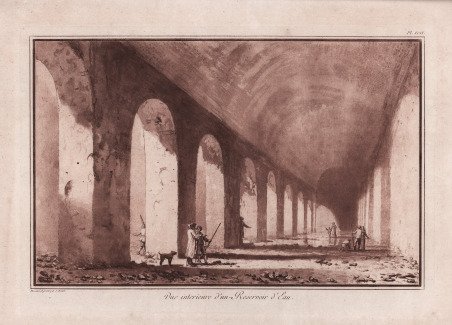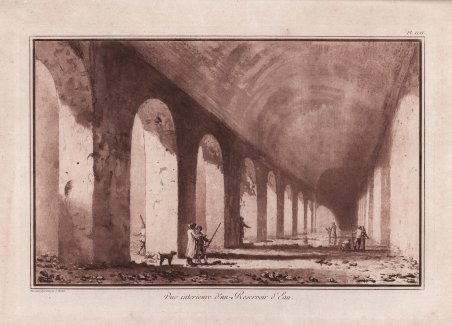Tratta dalla celebre opera di Jean Houel Voyage Pittoresque des Isles de Sicile, de Lipari et de Malte[.] edita a Parigi, in quattro volumi, tra il 1782-87. Dopo un primo breve tour in Sicilia e a Malta nel 1770, Jean-Pierre-Louis-Laurent Hoüel nel 1776, dopo aver ottenuto il finanziamento dal re Luigi XVI, decide di compiere il Grand Tour in Sicilia finalizzandolo alla pubblicazione di un’opera che illustri le antichità, i fenomeni naturali, gli usi e i costumi dell’isola. L’artista aveva preventivato di restare in Sicilia un anno, ma gli sarà necessario un periodo di oltre tre anni, fino al giugno del 1779. Hoüel terrà un Journal, ovvero un diario diviso in più quaderni, al quale affidare impressioni ed annotare itinerari ed incontri; servirà anche per tracciare veloci schizzi delle amate antichità e per redigere il testo dell’opera che pubblicherà. Dai “quaderni” si apprende, inoltre, che l’itinerario esposto nei quattro volumi sarà virtuale perché in realtà Hoüel visiterà alcune città più volte per osservare, durante l’anno, le festività o altri eventi. Rientrato a Parigi nell’estate del 1779, l’artista salda il suo debito col re offrendo quarantasei vedute eseguite a gouaches, oggi conservate al Louvre. Per pubblicare il suo lavoro aveva bisogno di un ulteriore finanziamento e vendette a Caterina II di Russia oltre cinquecento disegni e dipinti realizzati in Sicilia, parte dei quali, i soli 264 superstiti, si custodiscono all’Ermitage di San Pietroburgo. Del resto, in quegli anni l’abate Saint-Non aveva dato alla luce il primo tomo del suo Voyage (1781-1786), e questa concorrenza non giovò certo alla causa di Hoüel. Lavorerà poi con ferrea disciplina per otto anni a incidere da solo, con la tecnica dell’acquatinta, le 264 lastre di rame del Voyage pittoresque des isles de Sicile, de Malte et de Lipari […], edito a Parigi, in quattro volumi, tra il 1782-87. L’uso dell’acquatinta nei toni del seppia consentirà all’autore di ottenere incisioni con effetti chiaroscurali più vicini alla sua sensibilità di pittore. ' Acquatinta stampata in seppia, in eccellente stato di conservazione. A beautifully rendered plate from Voyage Pittoresque des Isles de Sicile, de Malte et de Lipari. Le Voyage Pittoresque by Hoüel is a travel diary characteristic of the 18th century in which the author reveals both his scientific and aesthetic vocation. His book has enormous documentary value due to the accuracy of the illustrations and the richness of the text, which includes didactic notes and autobiographical and travel anecdotes. Hoüel’s journey was funded by the king of France, Louis XVI. Although he was only intending to be in Sicily for one year, he eventually stayed there for four years. His financial support was tendered on the condition that the money advanced by the king should be returned along with the proceeds of the published book. However, the repayment was demanded too soon for Hoüel and the artist decided to repay part of the debt by donating some Sicilian paintings. Forty-six gouaches were chosen to enlarge the Painting Museum of Versailles (today preserved at the Louvre). Eventually, Hoüel and his creditor, the Compte Angiviller (administrator of the King’s properties) went their separate ways and the painter was left to manage the publication of his book himself. The Russian Empress Catherine II became interested in the acquisition of Hoüel’s ‘Cabinet’, comprising approximately five hundred gouaches, for which she paid forty thousand pounds. The works were sent to Saint Petersburg; 240 drawings disappeared and 264 works are now preserved at the HermitageMuseum. The four folio volumes of the VOYAGE PITTORESQUE DES ISLES DE SICILE, DE MALTE ET DE LIPARI, où l’on traite des Antiquités qui s’y trouvent encore; des principaux Phénomènes que la Nature y offre; du Costume des Habitans, & de Quelques Usages was printed from 1782-1787. They contain 264 aquatint plates on 263 leaves (plates 245 and 246 printed on the same leaf), all printed in sepia. ' Aquatint engraving printed in sepia on laid paper, very good condition. Cfr. Cremonini pagg. 129/132, 74.


Scopri come utilizzare
Scopri come utilizzare

